Introduction
The Hawker Siddeley HS748 Series 2 is one of the latest aircraft
published by Rick Piper and his team. It was made available for
FS9 in 2006.
On the
Classic British Flight Sim![]() site you can download a version that is ported to FSX, and that
is the version under review here.
site you can download a version that is ported to FSX, and that
is the version under review here.
Background
The Hawker Siddeley HS748 began life as the Avro 748 and the
prototype flew for the first time on 24th of June 1960. The 748
had to compete with the Fokker F-27 which was already available
and the Handley Page Herald which would become available for
delivery in 1961. In order to compete with these planes Avro
decided to give the 748 good rough field performance.
Series 2 flew first in November 1961, and that is the version
modelled here. The series 2 had two Rolls Royce Dart 532 RDa7
engines and could transport between 40 and 58 passengers. With
this it performed similar to the F-27 and the HP Herald.
In 1963 Avro was integrated in Hawker Siddeley Aviation and the
Avro 748 became the Hawker Siddeley HS.748. Production ended in
1988 with 382 airplanes of all versions built.
Download & Installation
This package is available at Classic British Flight Sim (http://www.cbfsim.org/cbfs_lib/thumbnails.php?album=18
![]() )
as download of one .zip file.
)
as download of one .zip file.
The file does not come with an auto-installer so you need to
copy and paste the files or unzip to the main FSX directory.
Unfortunately this is not explained in the documentation. This
will not be a problem for seasoned freeware users, but it might
be a little daunting at first for the uninitiated.
 The Hawker Siddeley (AVRO) HS748 was a successful turboprop and is a beautiful addition to your FSX or FS9 fleet |
What You Get
The package comes with six external models and a stunning 94 liveries, here's just a few of them.
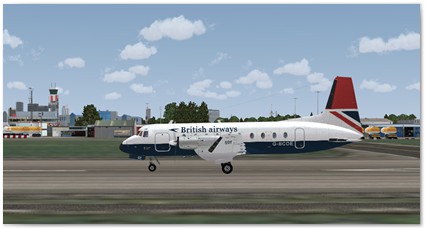
|
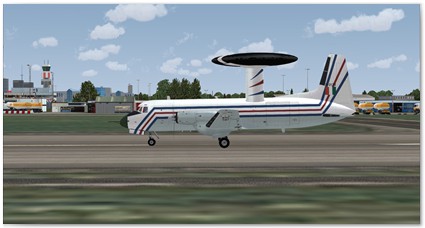
|
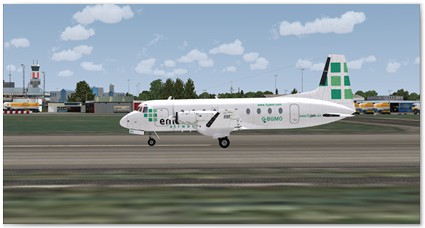
|
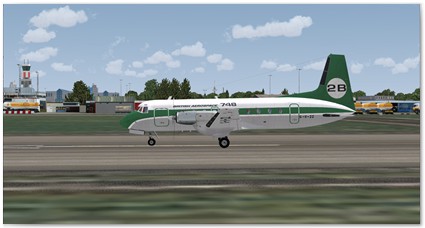
|
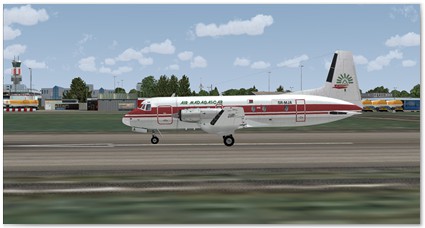
|
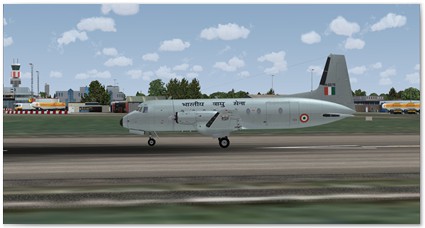
|
All variants use the same config file so there is no difference between the flying characteristics of a series 2A, series 2B (with different engines and payload), or AEW version of the plane, this is also true for the panel.
All versions come with the same cockpit and a custom soundset. Last but not least, the package includes the cockpit manual in both Word and PDF format. Read this manual carefully, especially the checklists, or you will be very frustrated trying to start the engines!
External Model
The external model is very good even when compared to modern standards. When you realize that this is a model designed for FS9 six years ago it is stunning! Not once when considering the outside of the plane did I get the feeling that I was looking at a dated model.
Of course we now have HD models from the top end developers but this plane still holds its own and shines with accurate depiction of the real plane and beautiful liveries. The lady sure ages gracefully!
The model has enough external details to make it look lifelike. The windows and doors are proper 3D models, the undercarriage, engines and wings have lots of details and the airstairs looks the job.
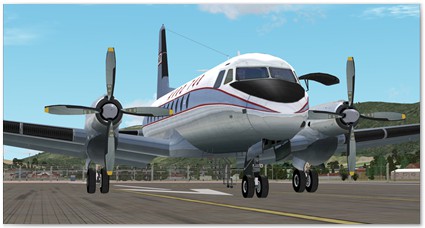
|
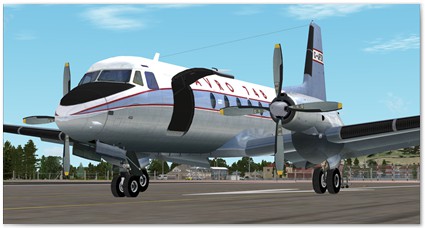
|
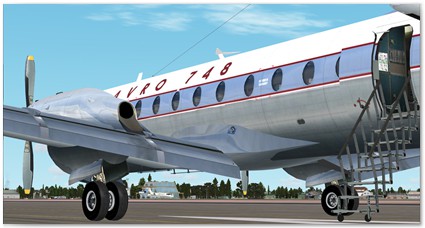
|
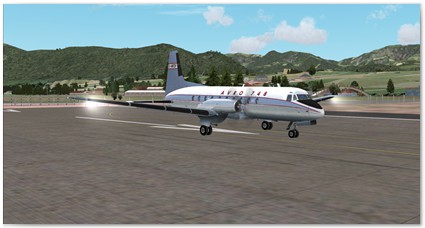
|
Animations include standard flaps, rolling wheels, feathering props, and extending stairs.
I had some problems with opening the Large Freight Door in the LFD models and decided that it could not be opened. Luckily Rick Piper responded to the review and pointed out that the door was in fact 3D modelled and could be opened. When I then took another look at the model I found that the front cargo door and the Large Freight Door used the same control to open.
All in all the externals are very well done without breaking new ground.
Internal Model
The internal model is all about the cockpit. Although you can look into the cabin from the outside in, no cabin view is available. Indeed when using Ctrl + ENTER to move back you will find that the cabin is not modelled.
So let’s talk about the cockpit!
In FSX the virtual cockpit has gradually become the standard way of flying, so the VC is the first thing I look at in a new plane. It has to be crisp, clear, well modelled and functional. Like the external model the HS.748 holds its own without being at the absolute cutting edge. The cockpit is fairly crisp, but the lettering would improve with higher resolution. The clarity is excellent without any artificial dirt on the windows.
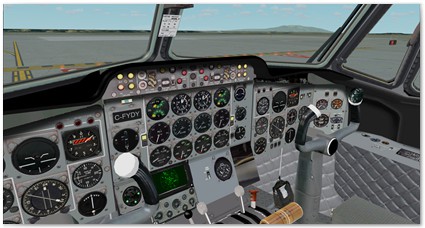
|
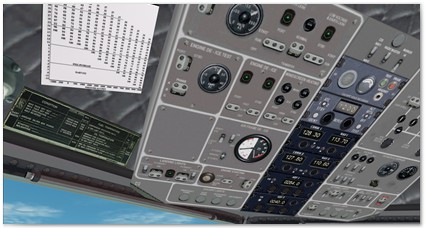
|

|
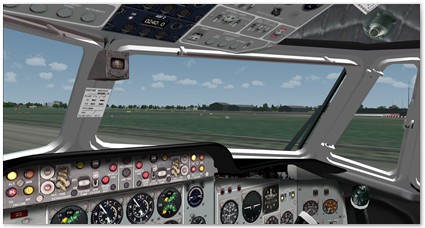
|
The modelling of the VC is again, pretty good but you will notice that not all panels, knobs or gauges are rendered in 3D. Sometimes it is more easy to use the 2D pop up panels for some of the functions, but everything you need to do in order to fly the plane can be done from the virtual cockpit.
The overall impression is certainly pleasing and functional but compared to today’s high end of the market it lags a little behind. Compared to its rivals in the 2006 FS9 marketplace, the VC is absolutely on par with most of the competition, be it commercial software or freeware.
The 2D panels are of the same high standard as the VC. Again, everything you need to fly the plane is easily available and the included views are of a good quality.
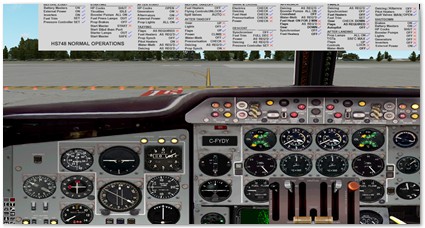
|

|
Apart from the main panel, the panels include:
Data card, engine selector, fuel trim card, overhead port (left), overhead starboard (right), radio stack, port side panel, starboard side panel, quadrant, auto pilot, pedestal, fuel trim controller and cross feed cock. If it is needed to fly the plane it is there. I haven't found anything that is needed to fly the airplane (Using normal procedures) that was not modelled.
Both the virtual cockpit and the 2D panel have a trick up their sleeve that was fairly unique in 2006 and is not even standard at this time. The plane has interactive check lists. These work very well and are a unique selling point for the plane. Be aware however that even the interactive checklists do not include all the information needed to fly the plane so the cockpit manual is still required reading.
As a last resort for people unable to get the plane started, a Rapid Start button is included in both 2D and virtual cockpit.
Sounds
The included engine sound set is of a high quality. The same is true for the flaps and gear. Switches in the cockpit do not make any sound at all and that is truly a shame because it does has an impact on the overall experience. The engine sounds are very good however and add a lot to the experience. Turn it up loud and hear the turbines spool up, brilliant!
Flight Characteristics
If the plane is flown in accordance with the cockpit manual it stays close to the published speeds, range and ceiling.
The readme file has the following to say about the flying by the numbers:
“Published figures for the HS.748 have wildly varying Cruise speeds so we settled for Cockpit Video Speeds & not inaccurate published figures.” Most common found cruise speed is 244 kts and that seems about right in this model. It is important to use the numbers from the cockpit manual because the engines will be damaged beyond repair when pushed too hard.
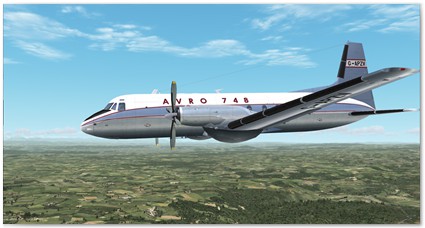
|
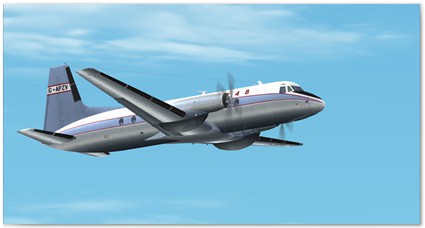
|
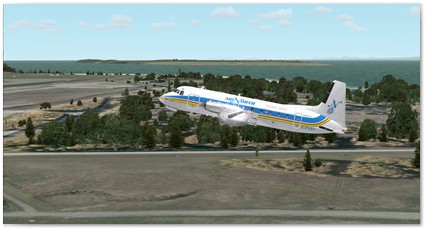
|
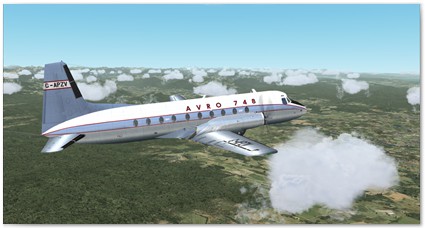
|
Flight dynamics
Hand flying the HS.748 in FSX is a pleasant pastime. The plane is very stable and easy to trim in all stages of flight. There is a little tendency to roll to the right but the effect is not very noticeable. The engines do react suitably slow to inputs when on the ground, but once airborne and with the corresponding higher rpm’s, the reactions seem to come more quickly. How realistic this is, is difficult to say. Performing extreme manoeuvres like complete rolls and even loops are possible with this model. Again it is difficult to say if this is realistic. One factor in favour of this being possible is the use of the Fokker F27 as display aircraft by the Royal Dutch Air Force.
One thing that feels very realistic is the need to slow down before descending. It is very difficult to bleed off speed once on final at too high a speed. If flown correctly to slow down before descent it is possible to make a very short landing which seems to be in accordance with the rough field performance of the plane.
All told, the plane feels like what I expect from a turboprop airplane of this size.
Documentation
Documentation consists of the cockpit manual in Word and PDF formats and the reference file and checklists. The cockpit manual is 18 pages long and describes what you need to know to the aircraft using normal procedures. It also has a small section containing an emergency checklist but this is very short. I think the available information is adequate but nothing more, there is no background information on the plane for example.
Value for money
Considering this plane is free it is of course great value for money. This statement is not doing the plane justice however. Compared to any of the more “lite” payware packages available this model more than holds its own. It looks right, it feels right and it has some features like interactive check lists and modelled failures that are missing in commercial available packages.
For the sheer fun this package brings I will not hesitate to compare it with the Flight1 ATR 72-500. The ATR might win on features, but the fun factor and price of 0 pounds, euros, or dollars make this model a great contender.
![]()
Verdict
![]()
|
• External Model: • Internal Model: • Sounds: • Flight Characteristics: • Flight Dynamics: • Documentation: • Value for Money: |
8.5/10 7.5/10 7.0/10 9.0/10 9.0/10 8.0/10 10 /10 |
Pros: • Good external and internal modelling • Great engine sounds • Wide variety of liveries/repaints available • Interactive check lists Cons: • No sounds for the switches in the cockpit • Resolution in the cockpit could be a little higher • All models share the same flight characteristics |
Final Mutley's Hangar Score 8/10
Kasper Hanselman
